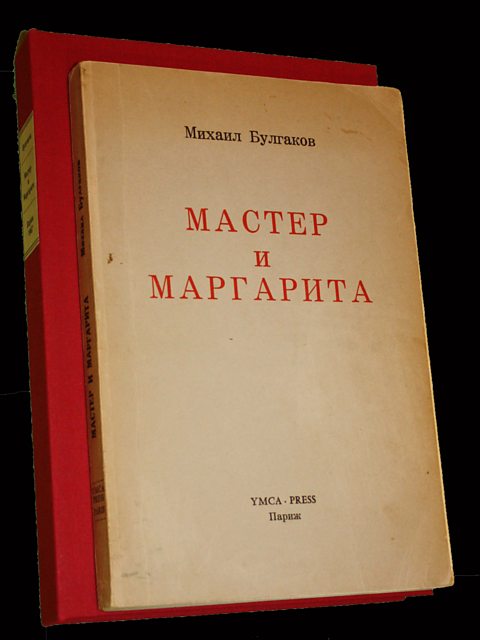Joyce’s seminal work of modernist literature was first published in serialised form in the literary magazine The Little Review from 1918 to 1920, but it was subsequently banned in the States and then in Britain after the New York Society for the Suppression of Vice filed obscenity charges. It was first published in book form in Paris, from where readers, including Anthony Burgess, sourced their secret copies.
Curiously though, in 1933, on e copy of the book was smuggled into the US on behalf of Random House founder Bennett Cerf, precisely in order that it would be found, and a legal challenge to the ban could be mounted.

The first book edition of The Master and Margarita by Mikhail Bulgakov (Paris: YMCA Press, 1967)
Mikhail Bulgakov, The Master and Margarita
Written between 1928 and 1940, Bulgakov’s satirical masterpiece was eventually published in Russian in 1967, but on ly in a censored version with a significant percentage of the text removed. Meanwhile, a samizdat [clandestine] copy, containing all the missing parts and notes on changed passages, was printed and circulated by hand in the tradition of dissident resistance activity seen throughout the early 20th century. The book circulated so widely that people used to speak in sentences from the novel, a secret code dividing those who had read it and those who hadn’t, marking not just cultural difference but radical political division.
Boris Pasternak, Doctor Zhivago
Pasternak wrote Doctor Zhivago on paper inherited from a friend and poet who was tortured and executed by the Soviet regime. He honoured his friend’s memory by writing a novel that defied the official demand that literature should glorify the revolution. With publication in Russian prevented, Pasternak used visiting Italian, English and French friends to smuggle copies out of the country.
But Doctor Zhivago was also on e of the many books that the CIA smuggled into the USSR as part of its propaganda drive against communism. A specially commissioned Russian-language version was printed in Washington in a pocket-sized edition, the more easily to secrete it about on e’s person, in food cans, and even in Tampax boxes.
Anne Frank, The Diary of a Young Girl
It is well known that Anne Frank’s diary was a secret book, that it was written during the two years Frank was hiding in a secret annexe to a house in the centre of Amsterdam during the German occupation, that it was found in the floor of the annexe and protected until it could be published.
But it is perhaps less well known that in its long afterlife this secret book became a smuggled book, with Anne becoming a role model for others in desperate situations of political persecution.
In fact, Nelson Mandela described how the diary was smuggled into South African prisons during the years of apartheid, giving inmates the will to survive their ordeal.
